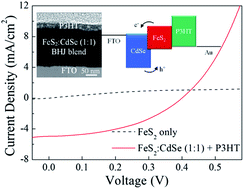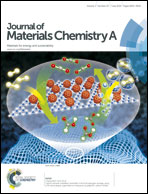Solution-processed inverted solar cells using an inorganic bulk heterojunction of iron pyrite nanocrystals and cadmium selenide quantum dots with a polymeric hole-transport medium
Abstract
Inverted solar cells were developed using a donor–acceptor (D–A) bulk heterojunction (BHJ) of iron pyrite nanocrystals (FeS2 NCs) and cadmium selenide quantum dots (CdSe QDs). The all-inorganic BHJ nanocomposites showed broad-range absorption and effective dynamics of charge dissociation and transfer through bi-continuous D–A interactions under a type II band-offset system. The developed solar cell, which contained an optimized ratio of FeS2–CdSe in the blend and a polymeric hole-transport layer between the photoactive layer and the anode electrode, showed a significantly enhanced photovoltaic efficiency. The long-term ambient stability of the inverted devices was better than that of conventional devices fabricated in this study, but was relatively lower than the air stability of other NC solar cells. Our findings suggest the potential of FeS2 NCs as an environmentally benign, earth-abundant material for solution-processed photovoltaic applications. The merits of an FeS2–CdSe D–A BHJ system with an inverted device architecture and its long-term stability are addressed.


 Please wait while we load your content...
Please wait while we load your content...